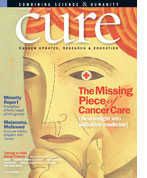Publication
Article
CURE
For When It Hurts
Author(s):
Pain management options for patients.
Oncologists can and do treat cancer pain, but patients with severe, intractable, or chronic pain should seek help from a palliative care team, pain specialist, or interventional anesthesiologist. Sometimes a psychologist or social worker may also become involved because emotions, stress, and coping styles play a role in pain, says Ann Berger, MD, an oncologist and palliative care physician in Bethesda, Maryland, and the author of Healing Pain.
Specialists have many techniques they can recommend, ranging from heat packs and acupuncture to surgically implanted drug delivery pumps and precision nerve blocks. Pain may be caused by the tumor itself or by treatment, including radiation, chemotherapy, or surgery, that has caused nerve damage or other painful side effects.
Medication is almost always part of pain management, and some patients may need two drug regimens, one around-the-clock medication to stay in front of chronic pain and one fast-acting medication to counter sudden and intense episodes of breakthrough pain.
Sometimes doctors use a cocktail of drugs, including non-narcotic medications that can act synergistically, or they “rotate” opiates, switching from one to another if a patient develops tolerance. The goal is to keep pain under control so patients can concentrate on fighting their cancer, not their symptoms.
“We usually start with an opioid the patient has used before and found effective, without significant side effects,” says Janet Abrahm, MD, of Dana-Farber Cancer Institute in Boston. “If they’ve taken oxycodone after a wisdom tooth extraction, for example, or morphine after surgery, we’ll start with that. Since each person is unique, we may have to try a variety of opioids to find the one that is most effective with the fewest side effects, or that comes in a form that the patient prefers—a patch, for example, rather than pills that deliver eight or 12 hours’ worth of drug.”
When necessary, Dr. Abrahm says they work with insurance plans to make sure the patient will be able to get the right drugs, but that’s usually not a barrier for cancer pain.
One of the biggest barriers to pain control comes not from the doctors or insurers, but from “opiophobic” patients who are reluctant to take powerful painkillers that have social stigma. Some clinicians and researchers report increased concern about addiction in elderly patients and by ethnic minorities, a concern experts say is misplaced. It is extremely rare for a cancer patient to develop an addiction to a narcotic or opiate that is correctly prescribed (unless they have a history of substance abuse), says Dr. Berger.
Patients may also shun drugs that make them drowsy, but the sleepiness side effect usually wears off within a few days. Other side effects, such as constipation, can be controlled with their own remedies. Whatever the issue, patients should talk to their doctor about solutions or alternatives.






